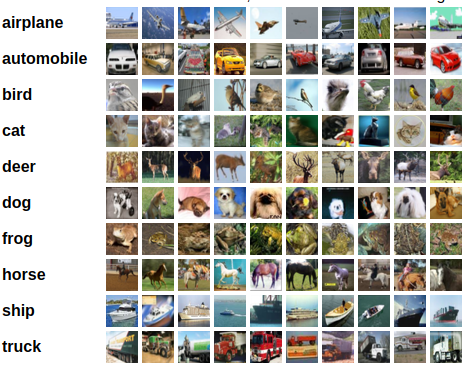BIGBALLON / Cifar 10 Cnn
Programming Languages
Projects that are alternatives of or similar to Cifar 10 Cnn
Convolutional Neural Networks for CIFAR-10
This repository is about some implementations of CNN Architecture for cifar10.
I just use Keras and Tensorflow to implementate all of these CNN models.
(maybe torch/pytorch version if I have time)
A pytorch version is available at CIFAR-ZOO
Requirements
- Python (3.5)
- keras (>= 2.1.5)
- tensorflow-gpu (>= 1.4.1)
Architectures and papers
- The first CNN model: LeNet
- Network in Network
-
Vgg19 Network
- Very Deep Convolutional Networks for Large-Scale Image Recognition
- The 1st places in ILSVRC 2014 localization tasks
- The 2nd places in ILSVRC 2014 classification tasks
-
Residual Network
- Deep Residual Learning for Image Recognition
- Identity Mappings in Deep Residual Networks
- CVPR 2016 Best Paper Award
-
1st places in all five main tracks:
- ILSVRC 2015 Classification: "Ultra-deep" 152-layer nets
- ILSVRC 2015 Detection: 16% better than 2nd
- ILSVRC 2015 Localization: 27% better than 2nd
- COCO Detection: 11% better than 2nd
- COCO Segmentation: 12% better than 2nd
- Wide Residual Network
- ResNeXt
-
DenseNet
- Densely Connected Convolutional Networks
- CVPR 2017 Best Paper Award
-
SENet
- Squeeze-and-Excitation Networks
- The 1st places in ILSVRC 2017 classification tasks
Documents & tutorials
There are also some documents and tutorials in doc & issues/3.
Get it if you need.
You can also see the articles if you can speak Chinese. 
Accuracy of all my implementations
In particular:
Change the batch size according to your GPU's memory.
Modify the learning rate schedule may imporve the results of accuracy!
| network | GPU | params | batch size | epoch | training time | accuracy(%) |
|---|---|---|---|---|---|---|
| Lecun-Network | GTX1080TI | 62k | 128 | 200 | 30 min | 76.23 |
| Network-in-Network | GTX1080TI | 0.97M | 128 | 200 | 1 h 40 min | 91.63 |
| Vgg19-Network | GTX1080TI | 39M | 128 | 200 | 1 h 53 min | 93.53 |
| Residual-Network20 | GTX1080TI | 0.27M | 128 | 200 | 44 min | 91.82 |
| Residual-Network32 | GTX1080TI | 0.47M | 128 | 200 | 1 h 7 min | 92.68 |
| Residual-Network110 | GTX1080TI | 1.7M | 128 | 200 | 3 h 38 min | 93.93 |
| Wide-resnet 16x8 | GTX1080TI | 11.3M | 128 | 200 | 4 h 55 min | 95.13 |
| Wide-resnet 28x10 | GTX1080TI | 36.5M | 128 | 200 | 10 h 22 min | 95.78 |
| DenseNet-100x12 | GTX1080TI | 0.85M | 64 | 250 | 17 h 20 min | 94.91 |
| DenseNet-100x24 | GTX1080TI | 3.3M | 64 | 250 | 22 h 27 min | 95.30 |
| DenseNet-160x24 | 1080 x 2 | 7.5M | 64 | 250 | 50 h 20 min | 95.90 |
| ResNeXt-4x64d | GTX1080TI | 20M | 120 | 250 | 21 h 3 min | 95.19 |
| SENet(ResNeXt-4x64d) | GTX1080TI | 20M | 120 | 250 | 21 h 57 min | 95.60 |
About LeNet and CNN training tips/tricks
LeNet is the first CNN network proposed by LeCun.
I used different CNN training tricks to show you how to train your model efficiently.
LeNet_keras.py is the baseline of LeNet,
LeNet_dp_keras.py used the Data Prepossessing [DP],
LeNet_dp_da_keras.py used both DP and the Data Augmentation[DA],
LeNet_dp_da_wd_keras.py used DP, DA and Weight Decay [WD]
| network | GPU | DP | DA | WD | training time | accuracy(%) |
|---|---|---|---|---|---|---|
| LeNet_keras | GTX1080TI | - | - | - | 5 min | 58.48 |
| LeNet_dp_keras | GTX1080TI | √ | - | - | 5 min | 60.41 |
| LeNet_dp_da_keras | GTX1080TI | √ | √ | - | 26 min | 75.06 |
| LeNet_dp_da_wd_keras | GTX1080TI | √ | √ | √ | 26 min | 76.23 |
For more CNN training tricks, see Must Know Tips/Tricks in Deep Neural Networks (by Xiu-Shen Wei)
About Learning Rate schedule
Different learning rate schedule may get different training/testing accuracy!
See ./htd, and HTD for more details.
About Multiple GPUs Training
Since the latest version of Keras is already supported keras.utils.multi_gpu_model, so you can simply use the following code to train your model with multiple GPUs:
from keras.utils import multi_gpu_model
from keras.applications.resnet50 import ResNet50
model = ResNet50()
# Replicates `model` on 8 GPUs.
parallel_model = multi_gpu_model(model, gpus=8)
parallel_model.compile(loss='categorical_crossentropy',optimizer='adam')
# This `fit` call will be distributed on 8 GPUs.
# Since the batch size is 256, each GPU will process 32 samples.
parallel_model.fit(x, y, epochs=20, batch_size=256)
About ResNeXt & DenseNet
Since I don't have enough machines to train the larger networks, I only trained the smallest network described in the paper. You can see the results in liuzhuang13/DenseNet and prlz77/ResNeXt.pytorch
Please feel free to contact me if you have any questions!
Citation
@misc{bigballon2017cifar10cnn,
author = {Wei Li},
title = {cifar-10-cnn: Play deep learning with CIFAR datasets},
howpublished = {\url{https://github.com/BIGBALLON/cifar-10-cnn}},
year = {2017}
}

